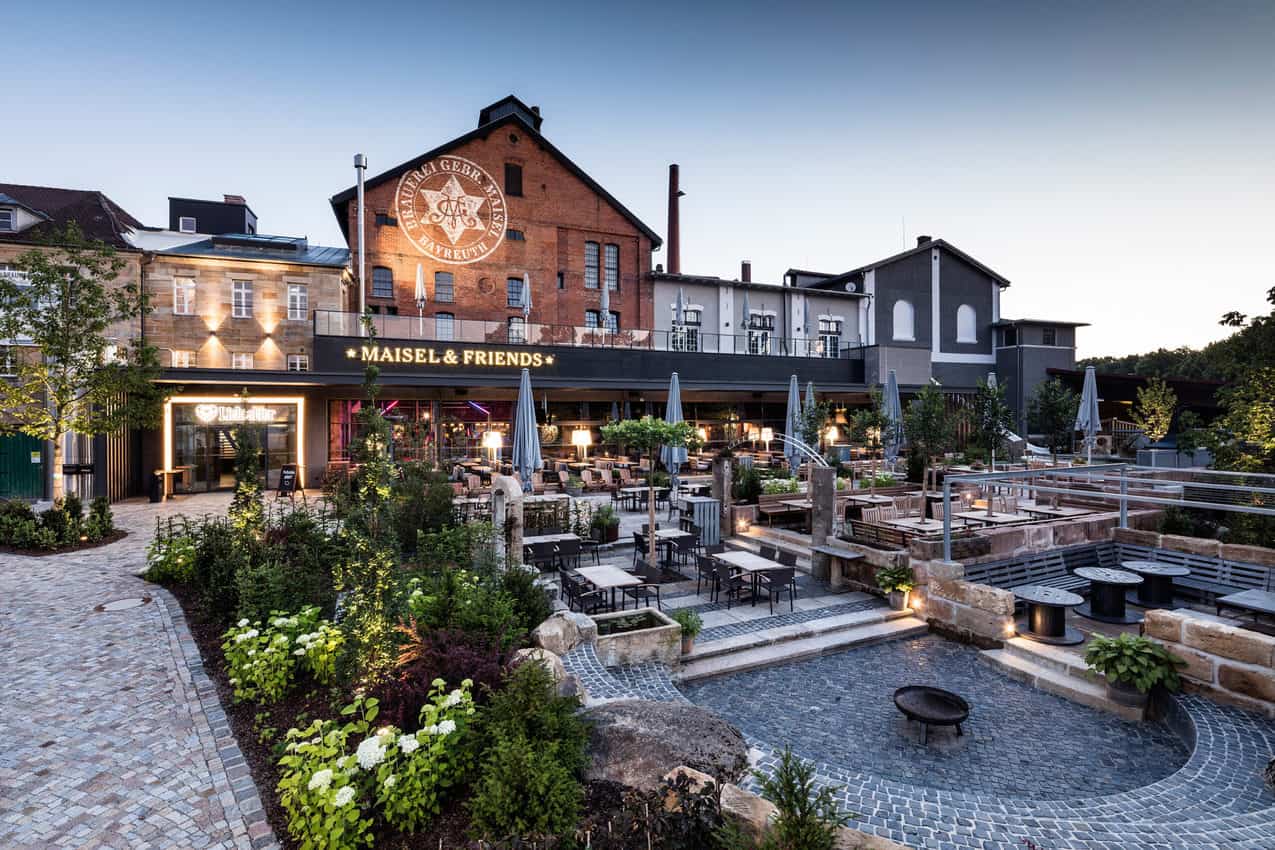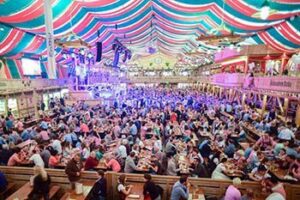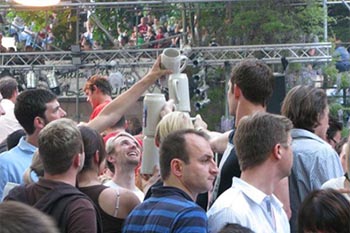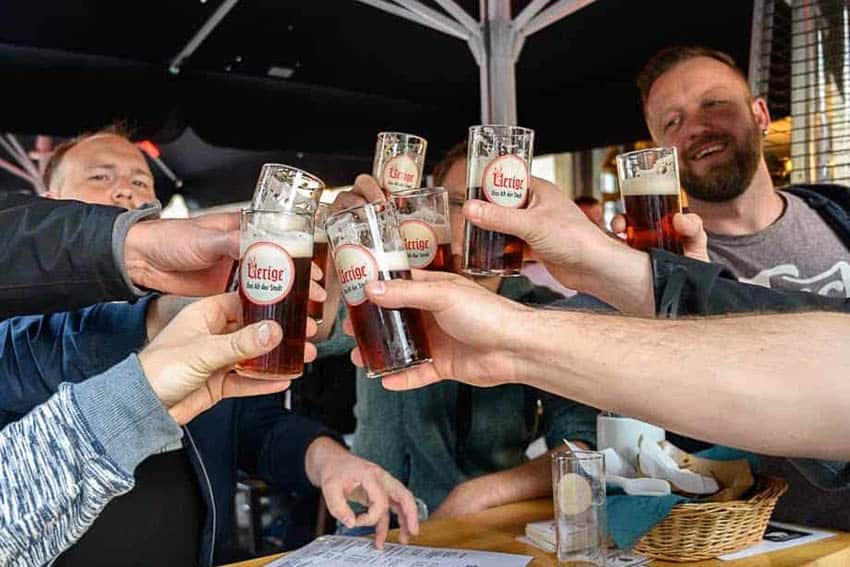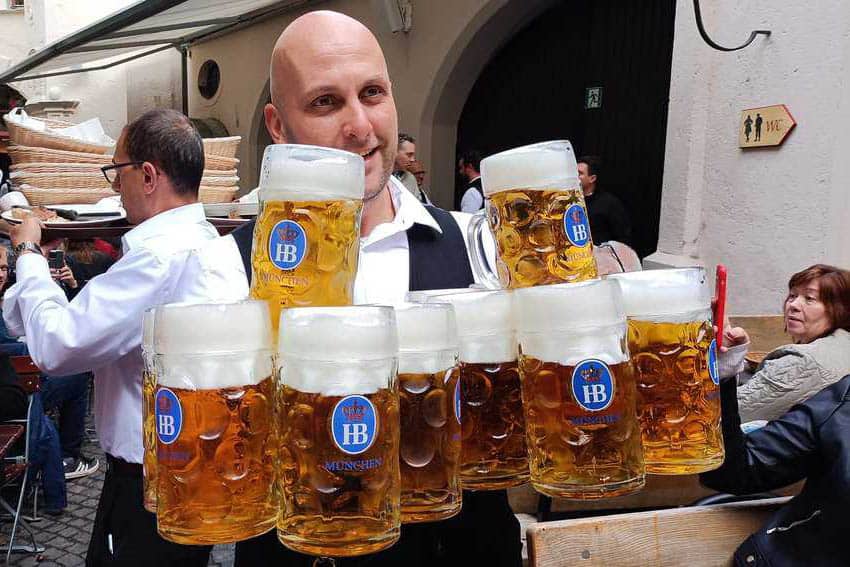
As beer tankards empty, the mood becomes increasingly merry while the scent of almonds, smoked mackerel, and oom–pah music fills the air.
By Cindy-Lou Dale
GoNOMAD Senior Writer
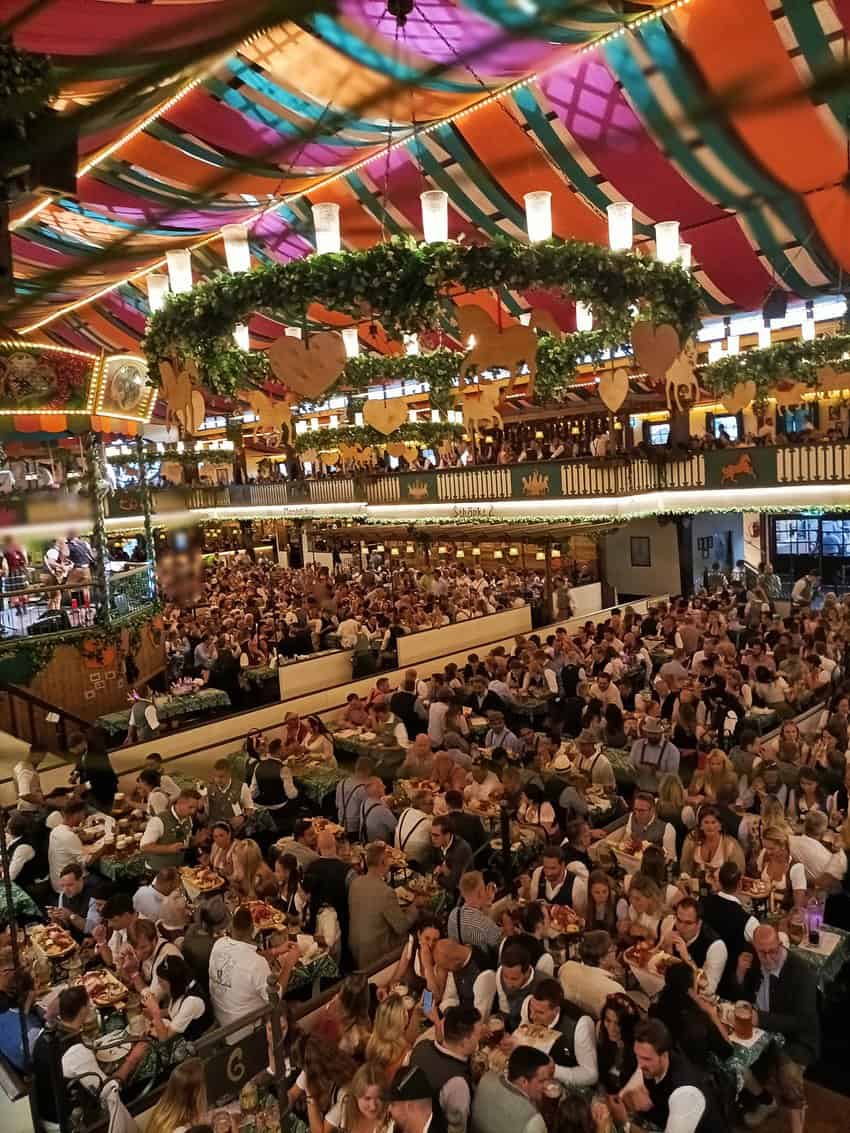
Of the seventeen large beer tents, it’s the colorful Art Nouveau façade of the ‘Marstall’ marquee that catches the eye, with its illuminated quadriga (a fast two-wheeled chariot pulled by four horses) above the entrance.
It gives a preview of the flamboyant interiors, which seat 3,200. Inside are dazzling decorative horses and a tall ceiling tented in broad swathes of fabric in aquamarine, tangerine, and electric pink.
The ‘Marstall’ marque is the historic name for the Royal Riding School who; in 1810, held a horse race on Theresienwiese (Oktoberfest’s location) in honor of a historical royal wedding.
The marquee is packed with beer lovers from around the world, the majority dressed in traditional Bavarian costumes – Dirndl dresses for the ladies and Lederhosen for the men.
Professional waiters’ sachet around the wooden tables – some bear ten tankards of beer, while others wield trays, carried with one hand above their heads, ladened with mouthwatering Bavarian cuisine.
German Oktoberfest cuisine is traditional crispy spit-roasted chicken, roast pork, roasted ham hock, Bavarian sausages, pretzels, cheese noodles, potato pancakes, and sauerkraut.
Each tent has a unique dish- sugared pancakes with plums, apple sauce, and truffle pasta – and all have certified organic, vegetarian, and vegan dishes. Then add to that a tasty Oktoberfest beer.
Rotating White Horses
On the colorful carousel bandstand, with its slowly rotating decorative white horses, a six-piece orchestra are playing traditional oom-pah music.
“Ein Prosit, ein Prosit der Gemütlichkeit” (a toast, a toast to coziness)

On arrival, the atmosphere is convivial. At the long tables, everyone introduces themselves with hugs and two-cheek kisses.
Beer drinkers loudly clunk their tankards together and sway to the slow, rhythmic music, whilst others take their partners for a waltz in any space they can find.
Later, after a brief oom-pah interval, the plates cleared, tankards refilled, the lights dimmed, and the mood immediately changed from merry to party.
The volume is turned up, and the once traditional oom-pah orchestra (Königlich Bayrisches Vollgas Orchester) morphs into an electrifying rock band, playing everything from ACDC to Queen. At once, everyone got up onto the benches. The ladies fluffed out their frocks and the men straightened their leather lederhosen braces and danced the night away.
It’s magical to watch how the world’s best beer and good music can unite people from around the globe. Just a few hours earlier they met as strangers, but now, with a shared Oktoberfest memory, they exchange business cards and part as friends, with a promise to reunite at the next festival.
Oktoberfest is the world’s largest folk festival, featuring a beer festival and a travelling carnival. It is held annually in Münich, Germany, from late September to around the first Sunday in October. At the heart of the Oktoberfest are 17 big beer marquees. Each has its own distinctive atmosphere.
This year, more than 6 million visitors attended the event. How it all came about is extraordinary. In 1810, Crown Prince Ludwig I of Bavaria and Princess Therese of Saxe-Hildburghausen chose Münich to be the location for their wedding, and why each year their vows are commemorated at Oktoberfest fairground. People arrive from around the world to hold a toast for the historic event and sing along to the oom-pah music for two long weeks.
For further Oktoberfest inspiration, see: www.oktoberfest.de
Münich Musts!
In summer months, thousands assemble in the city’s large chestnut tree-lined beer gardens and socialize over a liter of freshly tapped beer.
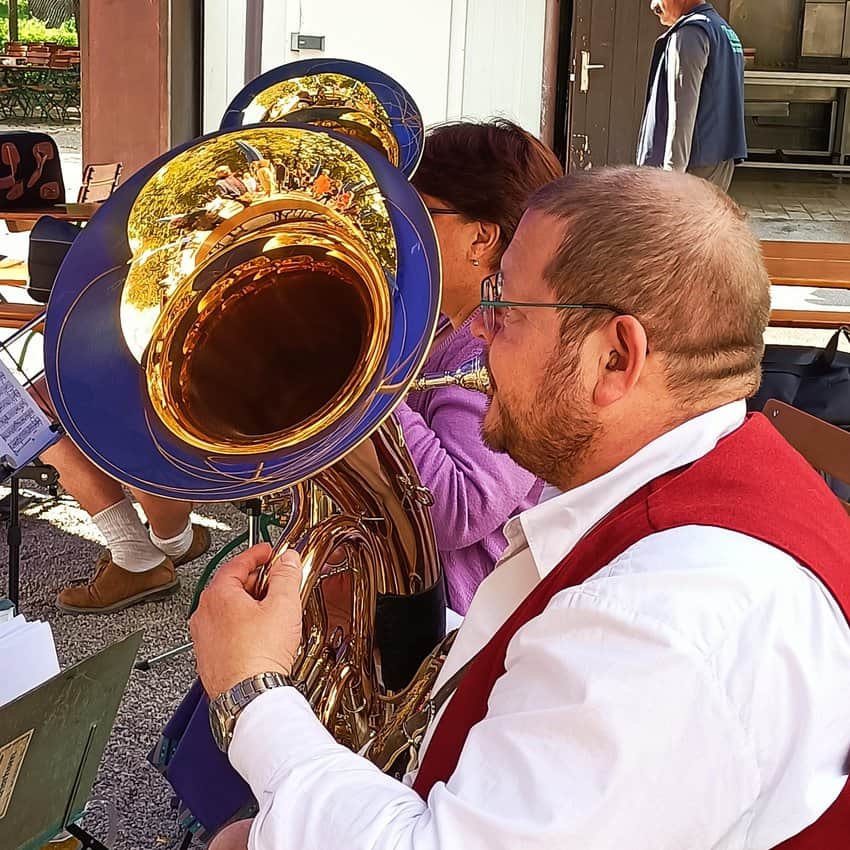
At the edge of an expansive, tree-festooned park is Koniglicher Hirschgarten (established in 1791), one of the largest beer gardens in the world.
Here, you could feast on strudel stuffed with mushrooms, cream cheese, sliced Vienna sausages, or a poacher’s sirloin steak served with wild mushrooms, bacon, and fried potatoes.
Alternatively, you could mimic the local beer garden pros who sit in an assigned self-service area (near the um-path bandstand) where they consume what they’ve brought in their handbaskets.
They arrive with their own crockery, cutlery, tablecloths, and hampers overflowing with bread, cucumbers, horseradish, cheese spread, grapes, ham, and sausages. They’re often joined by strangers and enjoy one another’s company. Be sure to look at the Hirschgarten’s deer and walk around the Royal Deer Garden.
Other popular meeting places are the numerous beer gardens at the Victuals Market. This beer garden is unlike the others and doesn’t belong to a specific brewery. Instead, kiosks serve beers from all major local brewhouses.
In true Münich style, you can sit in the shade of the chestnut trees and enjoy a Brotzeit (a traditional snack of meat, bread, ham, cheese, dried wurst, hard-boiled egg, and popular condiments such as pickles, radishes, and onions), while sipping at your litre of Münich’s best.
The most famous Beer Hall in the World
Hofbrauhaus is living history. It was established in 1589 for the exclusive use of the Duke of Bavaria, Wilhelm V, and his courtiers. King Ludwig I opened the tavern to the public in 1828, and 68 years later, once the Brewery was moved out of the building, the entire space was converted into a restaurant.
Brewing and drinking beer holds great sway in Münich’s community. Locals gather round in beer cellars, wearing traditional costumes, to drink and chat at the ‘Stammtisch’ – tables reserved for local social groups. Of the 3,500 locals who visit the 418-year-old Hofbrauhaus every month, only 616 esteemed long-term patrons earn the privilege to store their beer tankard in a chicken-wire ‘cage’.
These patron needs to personally wash and store their mugs which are kept under lock and key. For this, Hofbrauhaus charges an annual rental of €3.
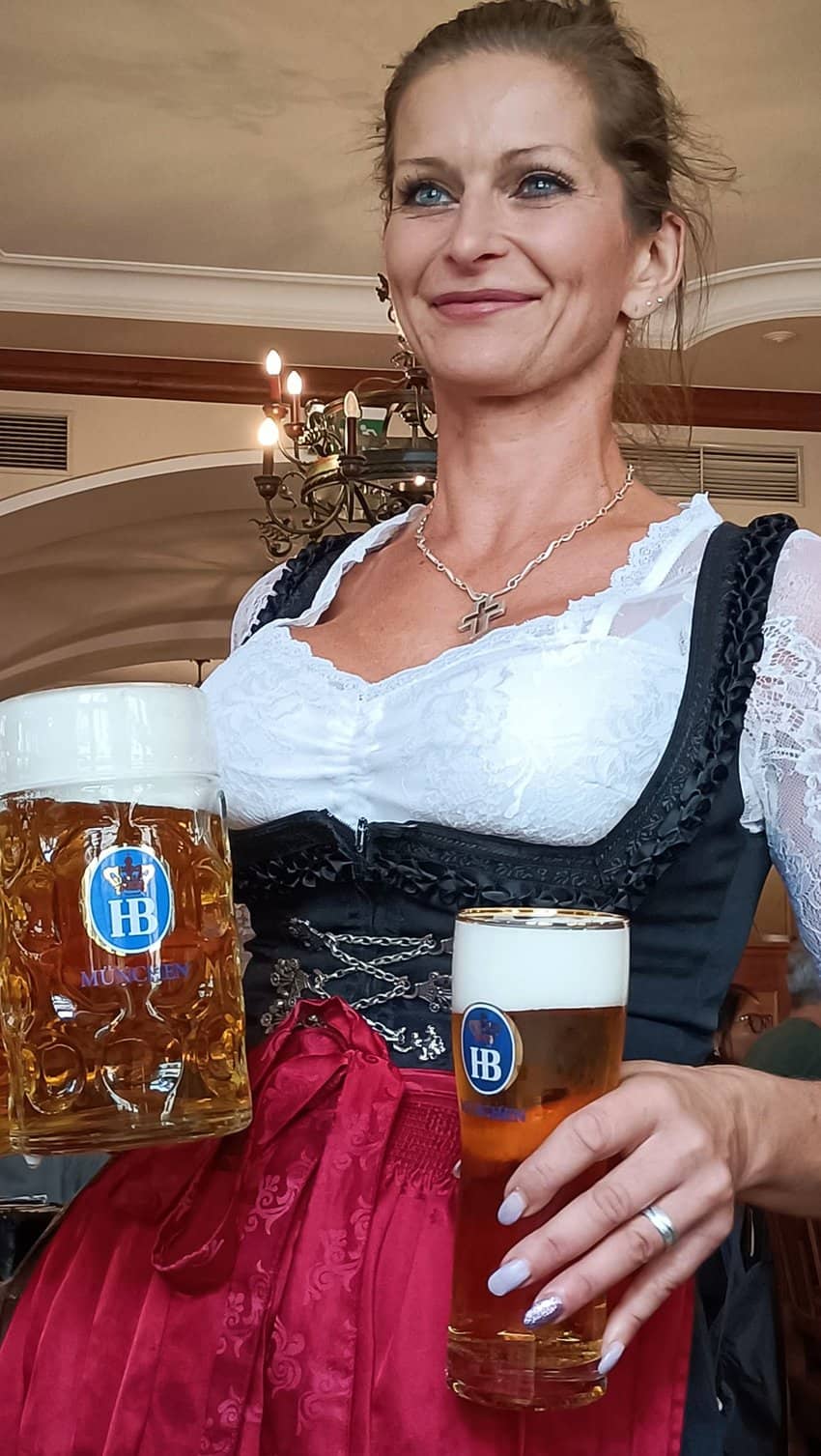
During its 434-year history, Hofbrauhaus has stayed open, even during WW2, barring a couple of days of intense bombing.
Ironically, like many public-facing businesses, they were forced to close for a few months during the Covid pandemic.
It’s all a living tradition of cultural exchange that remains unchanged outside the Oktoberfest.
Today Hofbrauhaus is the ultimate Bavarian cultural tavern experience where you get to soak up the sounds of the brass oom-pah band, and order a mug of cold Oktoberfestbier, along with a pretzel and a ‘Weisswurst’ – a white veal sausage served with home-made sweet mustard.
‘Leberkase’ is another favorite, a spiced-up meatloaf served in thick slabs.
As is ‘Rippchen,’ their chunky spareribs, others favored by locals are ‘Schweinebraten mit Knodel’ roast pork with dumplings, and ‘Hendl’ roast chicken.
Their signature dish is Schweinshaxen – a whole pork knuckle with crackling, dark beer gravy, and potato dumplings.
The meat literally melts in your mouth. You could literally eat it with a spoon.
But it’s not all about Beer
Just a quick wander around the city center’s Marienplaz, a pedestrianized shopping plaza lined with sidewalk cafes, you’ll hear a dozen foreign tongues and observe the chiming of the ancient Glockenspiel. Then there’s the Cathedral of Münich, the immensely tall, onion-domed Frauenkirche whose former Archbishop was Pope Benedict XVI.
Check out the statues of the lions on Residenzstrasse and the Theatinerkirche opposite; just around the corner is the National Opera House on Max-Joseph Platz, which is the beginning of the designer shopping mile of Maximillianstrasse.
Everything seems to flow in Münich: the River Isar, which runs through the city center, the beer gardens, and even the boundaries between work and play. Daily life merges into evenings, endless parties in posh nightclubs, and trendy warehouse bars where happy hour knows no end. The locals dress to impress and kiss both cheeks.
Everything about Münich is Unexpected
The Müncheners are jovial, eat hearty food, drink beer with breakfast, and clank their giant beer steins together, gently swaying to the sounds of an oom-pah band. It’s raw, chaotic, intoxicating, in-your-face, and utterly exciting.
For further Munich travel inspiration, see www.muenchen.de/en/tourism
- African Wildlife Safari and Zambezi Riverboat Cruise - October 30, 2024
- Taste of Ethiopia: a Food Tour of Addis Ababa - October 10, 2024
- The Elephant Camp, Victoria Falls, Zimbabwe - October 3, 2024


